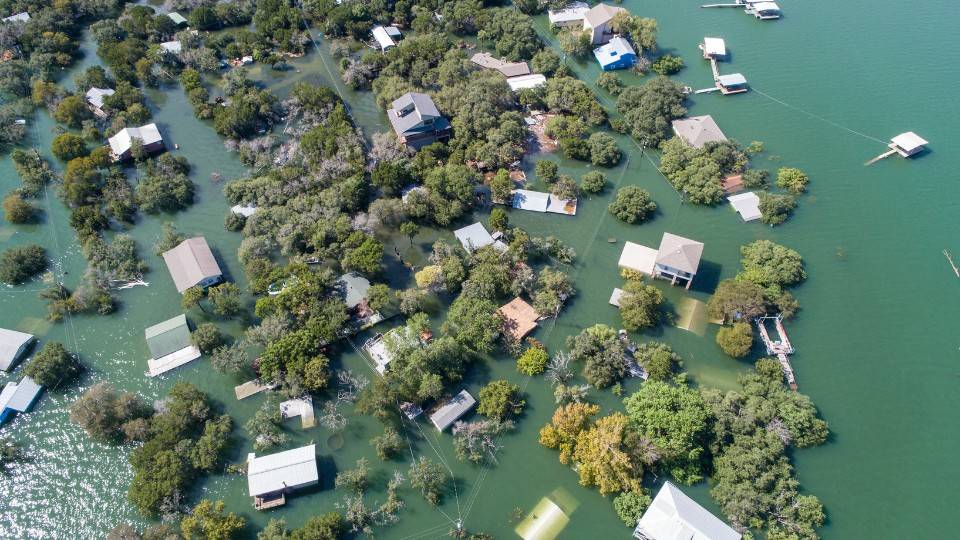Climate change is real.
The scientific community believes that the recent streak of floods in Europe and China is directly related to climate change.
An increase in the atmosphere’s temperature allows it to absorb more water vapor, resulting in more rainfall.
These catastrophic extreme weather events forced more than a million people to evacuate while the total damage was estimated at more than $20 billion.
Seven years ago I witnessed the devastating nature of floods myself and volunteered for the cleanup effort.
Let me share my experience and tell people how to get through a flood.
Is Climate Change the Culprit Behind Recent Floods?
Heavier Rainfall
After the heavy flooding that hit the western Europe from 12-15 July, a study was conducted to explore the possible influence of climate change on extreme weather events.
The researchers concluded that such torrential rainfall events are between 1.2 and 9 times more likely to happen in the future as a result of human-caused global warming.
Spring rains also cause faster melting of the snow, which contributes to flooding.
You could see this phenomenon in the western United States this spring when snowmelt-fed rivers reached peak flow since the 1950s.
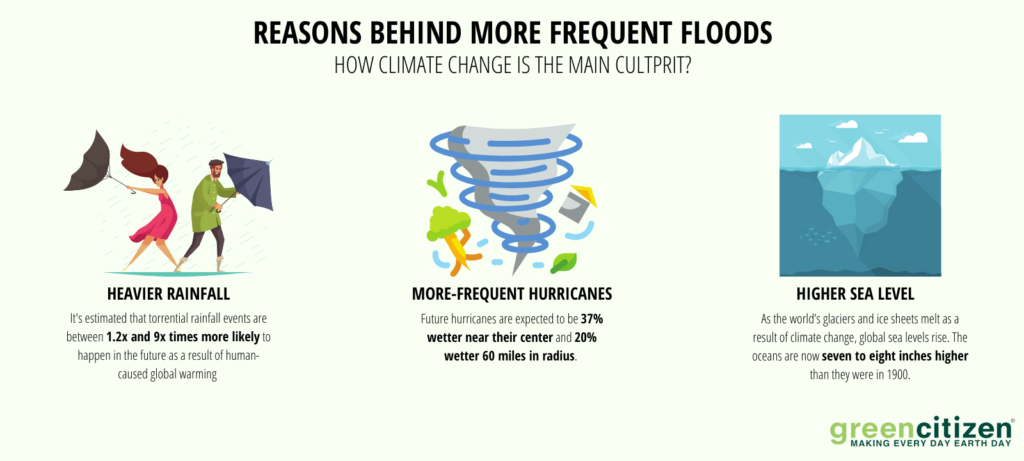
More-frequent Hurricanes
Climate change brings on more frequent hurricanes, and hurricanes bring heavy rainfall.
Let’s not forget 2017’s Hurricane Harvey that hit the coast as a category 4 storm and flooded more than 200,000 homes and businesses in Houston.
It was the nation’s wettest storm in nearly 70 years — moving slow and dumping more and more rain as it made its way.
In 2018, Harvey was followed by Hurricane Florence, which set 28 flood records.
Even “wetter” storms are predicted to happen, with future hurricanes expected to be 37% wetter near their center and 20% wetter 60 miles in radius.
Higher Sea Level
As the world’s glaciers and ice sheets melt as a result of climate change, global sea levels rise. The oceans are now seven to eight inches higher than they were in 1900.
Apart from increasing the power of storms, higher seas increase high tide flooding, which has doubled in the United States over the past 30 years.
Now combine this with gustier winds, and you have more destructive waves that get bigger and penetrate further inland.
Pinning floods on climate change alone is not easy, as there are also plenty of human-related factors like neglected waterways, urbanization, and alterations we make to land.
However, we can’t deny that climate change contributes to floods by affecting the natural water cycle.
The Most Devastating Floods in the Recent Years
2021 Henan Floods
Since 17 July, China’s Henan province has been ravaged by severe flooding caused by record-breaking rainfall of 201 mm in an hour. In just two weeks, 302 people have died and 50 more were reported missing. A total of 9.3 million people were affected.
The early footage from the province capital, Zhengzhou, showed subway passengers wading waist-deep inside their carriages and cars floating in the streets.
The Jingguang North Road Tunnel was quickly blocked when over 200 cars stuck inside like logs, jamming the city’s important transit artery.
2021 Maharashtra Floods
This summer, a series of destructive floods hit the Indian state of Maharashtra. As of 28 July, 251 people have died and over 100 were reported missing in torrents and landslides.
The flood was part of a series of connected extreme events that affected China and Europe. The events were triggered by an increase in rainfall during the Indian monsoon season caused by climate change.
In the rural areas, the flood caused tens of thousands of poultry and livestock deaths, while damaging over 200,000 hectares of crops.
2021 European Floods
Since 12 July, several European countries have seen catastrophic floods, which proved that not even the most developed countries are safe from nature’s wrath.
The floods affected several river basins across the continent, claiming 242 lives. Besides fatalities, the flooding caused widespread power blackouts, forced evacuations, and damage to property and agriculture worth more than €10 billion.
2020 East Africa Floods
In spring 2020, massive flooding and landslides affected Rwanda, Kenya, Somalia, Burundi, Ethiopia, Uganda, Democratic Republic of Congo, Djibouti, and Tanzania.
Heavy rain and thunderstorms started in Rwanda causing 5 fatalities from flooding and lightning strikes between 2 and 4 March.
The storms quickly spread to other central African countries, becoming one of the most devastating floods that hit the continent, with 453 deaths.
2018 Western US Floods
Heavy rainfall and hurricane-force winds in January 2018 caused a series of flash floods across the Western United States.
Cities like Las Vegas saw heavy flooding, with roads and highways closed for traffic.
Wildfires that rampaged through Southern California at that time only made things worse, causing mudflows and landslides that killed at least 23 people.
The Three-Phase Flood Safety Strategy
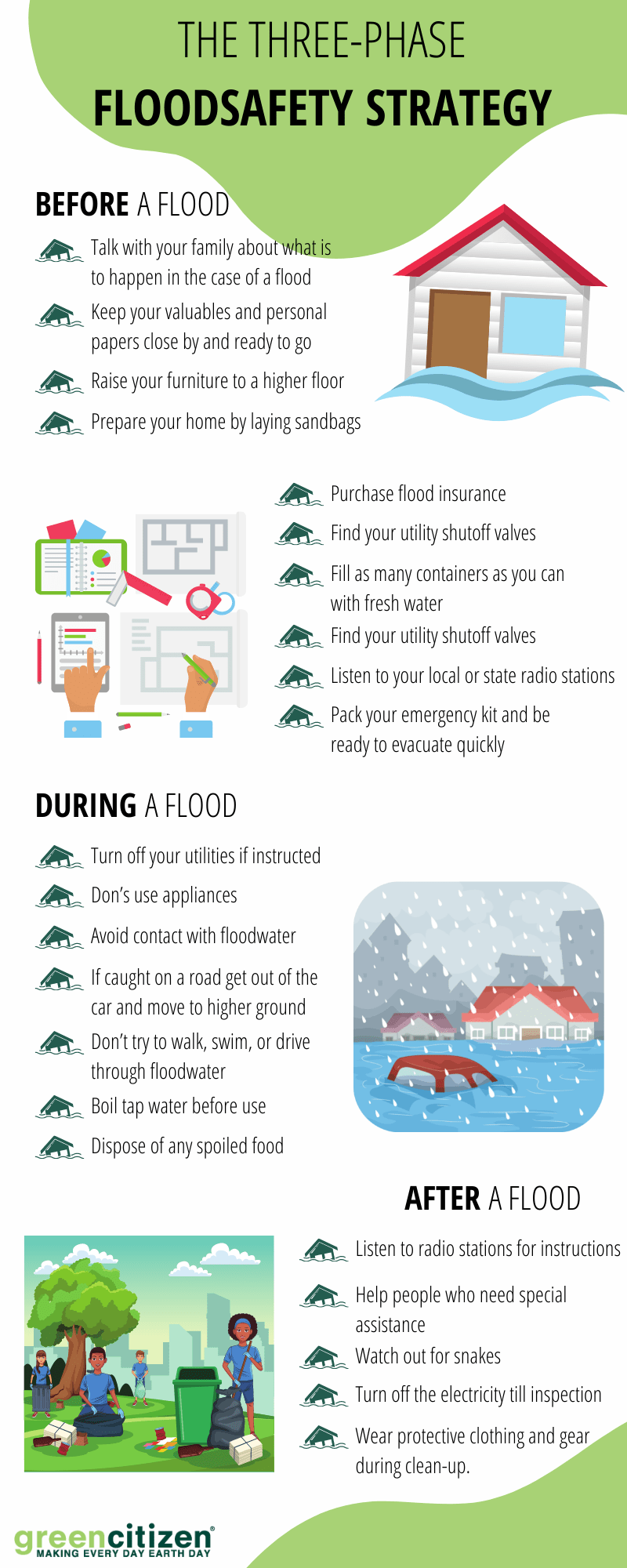
The Planning Phase: How Did I Prepare for Flood?
Although floods are more likely to occur in big river plains and coastal areas, flash floods can happen almost anywhere.
Just remember the Las Vegas flood of 2018.
So, it doesn’t hurt to be prepared for an emergency especially since you can use many of these points to prepare for other natural disasters as well, like wildfires, earthquakes, hurricanes, etc.
Make an Evacuation Plan
It doesn’t matter whether you’re a long-time resident or new to an area — in case of an incoming flood, you need to know exactly where to go.
In other words, you need to get out of Dodge as quickly as possible. I’d use flood maps to see where the worst flooding will be.
The last thing you want is to escape to an area that is flooded even worse.
When planning your evacuation route, find a place to go. For example, you can make a plan with a friend to evacuate to their place. Many communities will also have go-to areas for emergencies.
Finally, don’t forget to include your pets in the evacuation plan. Have their carriers close at hand, as well as their food. Pack something that will remind them of home, such as a pillow or blanket.
Have a Go-Kit Ready (3 Days of Supply)
If you need to evacuate to a safer place, your most important concerns should be food and water.
Stock up on bottled water before the flood, as it will soon get in high demand. You’ll need at least one gallon per person a day for three days.
The same goes for perishable foods. When I had to evacuate, we took with ourselves what we had at home. Since then, I’ve packed a survival bag that contains canned food, high-energy food, and cereal.
Pack extra batteries for the radio and flashlight. Candles can provide light and warmth but won’t last in high winds or rainy weather. Have some duct tape and plastic sheeting in case you need to fix leaks or cracks.
A pair of work gloves comes in handy in the clean-up, but also if you need to move heavier objects out of the way without cutting or scratching your hand.
Flood water is always mixed with sewage and all kinds of waste it picks up along the way. You DO NOT need an open wound in such an environment.
In case you get hurt, make sure you have a first aid kit ready along with all the medications your family needs, sanitary supplies, toiletries, etc.
I like to throw in a Swiss Army Knife or a multitool with a pair of pliers, a blade, and a can opener. It can help you with all kinds of tasks, especially if you need to whip up a shelter or awning to protect you from rain.
Believe me, everyone has one until they need one.
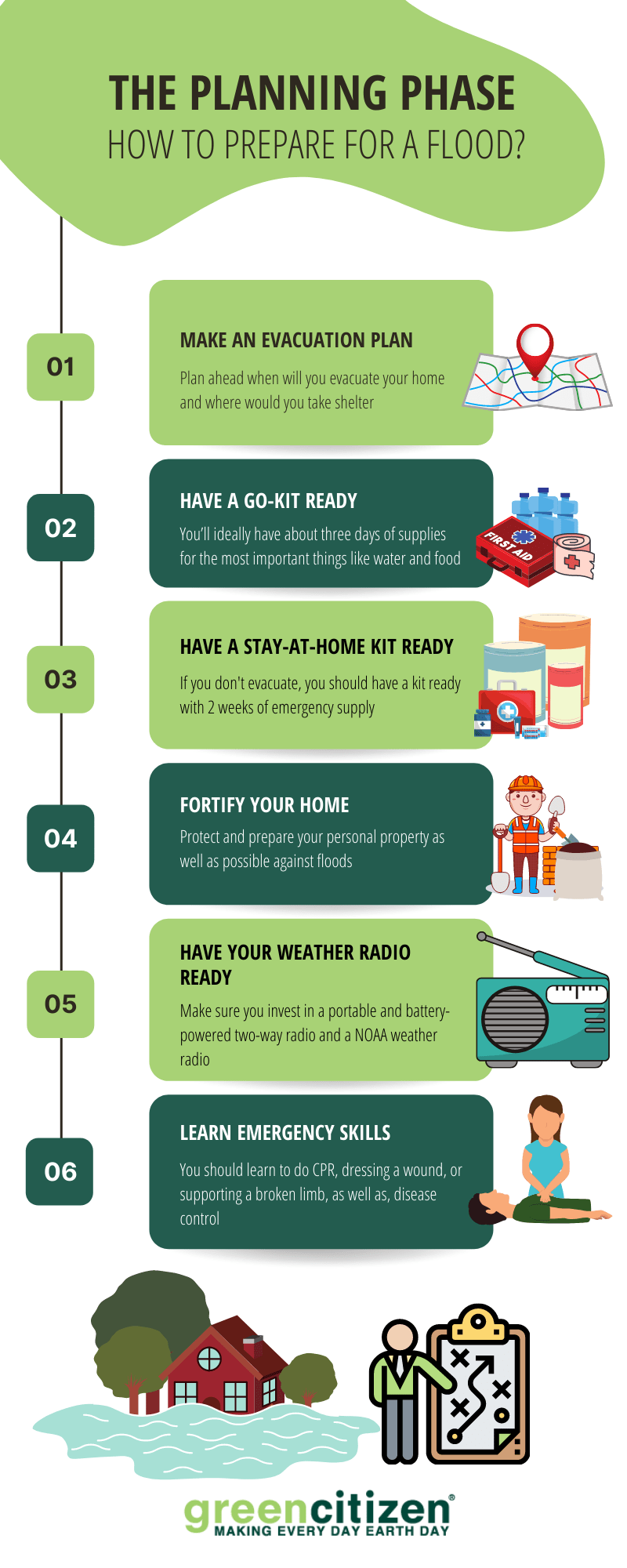
Have a Stay-at-Home Kit Ready (2 Weeks of Emergency Supply)
If you choose to stay at home, you need to make your stay as comfortable as possible given the circumstances.
For starters, you’ll need much more water and food. In this case, I recommend you fill 5- or 10-gallon plastic cans with tap water and store them on the upper floor.
As food is concerned, you’ll need a greater variety, as you want to maintain proper nutrition and keep the spirits high.
This is why your stay-at-home box should contain:
- Ready-to-eat canned meats, fish, vegetables, and fruit
- Protein bars
- Dry cereal
- Dried fruit
- Canned juices (they can get the low blood sugar up in seconds)
- Peanut butter
- High-energy food
- Comfort food
When you relocate to the upper floor, chances are that not everyone will have their bed. Invest in a few warm and comfy sleeping bags, so you all can stay together throughout the night.
Finally, don’t forget to include books, playing cards, or board games. These might seem like a waste of time and space, but in a stressful situation, you need something to help you wind down.
Fortify Your Home Against Floods
I admit, when our home was flooded back in 2014, we were caught by surprise. There haven’t been floods in that area for as long as people remember.
But it seems that climate change is taking its toll.
Raising my home on stilts was out of the question, so I asked a civil engineer for a professional evaluation. “Just tell me what can be done and what can’t,” I asked her.
My home has looked different since then, but it hasn’t lost its appeal.
It took some earthwork and landscaping, but now I have a natural flood barrier — levees on all four sides. Since I enjoy gardening, I planted the slopes with native, water-friendly plants which can absorb a lot of moisture themselves.
The only gap I left was for the main gate, but in case of flood, I could quickly block the passage with sandbags.
Before you decide on such a move, check if your local building codes allow this kind of alteration.
OK, this is cool, but what are you going to do about heavy rainfall? Won’t those levees turn your backyard into a huge swimming pool?
I gave this much thought and finally discovered something called a rain garden. These landscaping depressions both filter rainwater runoff and provide homes to birds and pollinators.
I had to amend the soil with a layer of clay. To finish it up, I used gravel, rocks, native flowers, and grasses that tolerate wet sites.
Have Your Weather Radio Ready
In a stressful situation, you want to get updates about the flood and the relief efforts, so you need a pocket radio that will kick in if your cell phone dies.
Any compact battery-powered radio will work, but if you’re building your floodsafety kit from scratch, I recommend the NOAA Emergency Weather Alert Radio. Apart from receiving regular FM stations, it also receives NOAA channels with warnings for different emergencies.
Throw in an extra phone charger, as nothing beats the cell phone with a full battery. For extra safety, get a portable charger that can give you at least 6 full charges.
When large areas are flooded, rescue teams often use helicopters or boats to look for survivors. Using a waterproof flashlight, you can let others know where you are.
Learn Some Emergency Skills
When natural disasters strike, the first responders are spread thin with constant calls and emergencies. It is on people like you and me to give a helping hand
These are the most valuable emergency skills you can learn to save someone’s life or make yours easier.
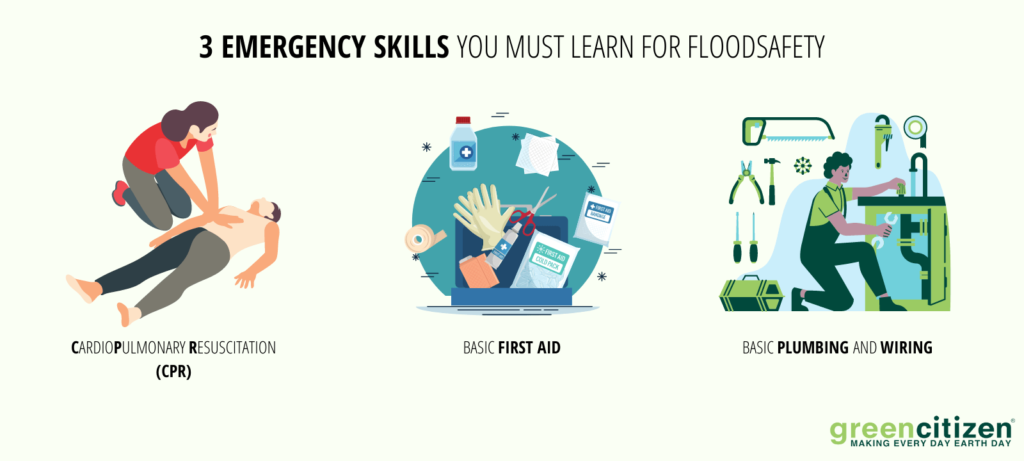
Perform CPR
Cardiopulmonary Resuscitation is performed to provide chest compressions and rescue breaths when the heart is not pumping at its normal pace.
For adults, apply 100 to 120 compressions per minute about 5-6 cm deep. Give two rescue breaths after every 30 compressions. ,
For children and infants, gently deliver quick compressions that are about 3.5 cm deep.
In both cases, you need to continue CPR until the first responders are ready to take over.
Know your First Aid Kit
There’s little use of your fancy first aid kit if your medical knowledge doesn’t go further than applying a band-aid.
People are likely to get hurt in a flood, so you should get familiar with every item in your first aid kit and how to use it.
Learn Basic Plumbing and Wiring
The set of survival skills for an urban environment is much different than surviving in the wilderness. When a flood strikes, it can be weeks before a repairman can arrive at your house to fix plumbing and electrical issues.
Learn basic plumbing and electric work to fix problems like replacing a burst pipe, dripping tap, or rewiring a simple wall outlet.
Be extra careful when working around electricity. Proceed only if you know what you’re doing and only if it’s absolutely necessary.
What to Do During the Floods?
Get Quickly to Safety
If you need to relocate to a safer place, I advise you to do it before the flood comes. When the flood comes, try to find dry routes to home or higher ground.
To achieve this safely and on time, make sure your vehicle has enough fuel. This is not the time to make a pit stop.
Local responders may already set barricades. Never drive around them, as they are there for a reason. Stay off bridges over fast-moving bodies of water, as the torrent can bring them down without warning.
If water lifts your car, don’t try to get out. The car shell is your best protection against other objects. However, if you see water rising, get on the roof.
While driving, keep an eye for washed-out roads, potholes, downed trees, and power lines, especially at night.
Stay Out of Water
Move away from places like storm drains, streams, creeks, and rivers. If you’re stuck at home, climb up to a higher flood using the stairs.
Skip the elevator this time, as you never know if it’ll run out of power.
Under no circumstances try to cross floodwater. If the torrent is strong, even ankle-deep water is enough to sweep you off your feet.
The floodwater is murky and you never know what lies beneath, and I’m not talking crocs and alligators.
There are storm drains, debris, and loose earth: one second you can be on your feet and another waist-deep in sewage.
When you absolutely need to cross a street, bring a stick to measure depth and find stable footing.
Still, the current might sweep you away if you’re not careful.
Don’t panic and try to turn over on your back. Keep your feet upstream to fend off objects floating with you. Try to find a strong branch or a lamp post to hold onto.
Save your strength and hold on tight.
You won’t be able to yell for a long time before your voice gives up. This is why I always carry a distress whistle on my keychain.
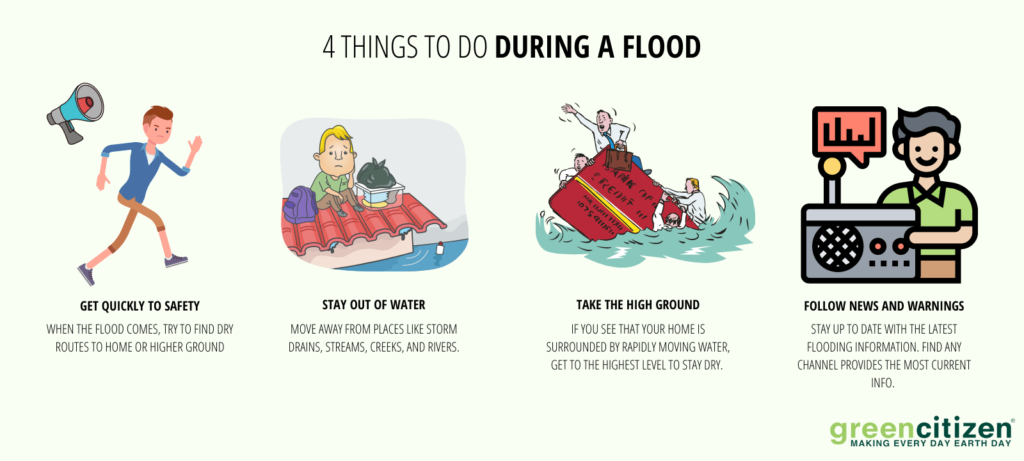
Take the High Ground
If you see that your home is surrounded by rapidly moving water, get to the highest level to stay dry. Avoid closed attics as you can easily get trapped by rising floodwater.
The roof might seem like the safest place, but believe me, it’s everything but safe.
The shingles are extremely slippery after heavy rains, not to mention the lichen and moss which both can get super slippery.
A sudden gust of wind can bring you down and make the flood the least of your concerns.
The roof is the wrong place to be for another reason — you’re completely exposed to falling trees and power lines.
The only good reason to go to the roof is to be seen by a rescue helicopter or boat.
Follow News and Warnings
Stay up to date with the latest flooding information. Find the TV station channel or website that provides the most current info.
This way you can hear about safety instructions such as if the tap water is safe to drink, as well as info on power outages, relief efforts, supplies.
What Should You Do After the Flood?
Step 1: Get Home Safely
Listen to the radio or monitor the emergency website to find out when it’s safe for you to return home. Your journey will likely be slow, as not all roads will be cleared of debris.
Step 2: Enter With Caution
If your home is badly damaged, keep out until a building inspector checks it. If you didn’t have time to turn off the gas, water, and electricity when you evacuated, now is the time to do it. You never know if those lines got damaged in the flood.
Step 3: Prepare for the Clean Up
Wear protective clothing such as rubber gloves, and rubber boots with thick soles. Start by removing standing water from your home. You can use a sump pump, wet-dry shop vacuum, or a water pump.
Step 4: Get Down to Cleaning
Mud and water that washed into your home not only contain sewage and garbage, but also dangerous chemicals. Not to mention that leftover water is likely to cause mold. Open up all doors and windows and proceed to scrub floors with hot water and heavy-duty detergent.
Step 5: Throw out Items That are Beyond Repair
When my family had to evacuate back in 2014, we didn’t have enough time to move the upholstered furniture to the upper floor. We had to throw out everything, including mattresses, pillows, carpets, and rugs.
The same goes for soft plastic containers and wooden homeware.
You’ll never be able to clean them 100% once they have been contaminated with floodwater.
You should also throw out all food, beverages, and medicines that were exposed to floodwater and mud. Even sealed containers like cans and bags are not safe for use anymore.
You can, however, hand wash dishes and cutlery, but make sure you use disinfectant along with the regular detergent.

Read More:
Additional After-Flood Tips
DO Check Around for Snakes
Humans are not the only ones affected by river flooding. Snakes, rats, and other dangerous animals may have taken refuge inside your home. Make sure to prod hidden areas with a stick. If needed, contact animal control to remove them.
DO Take Photos
Take pictures of your home for the sake of insurance. At this point, it’s important to document the damage, so make movies and pictures of the entire house. This precaution will make insurance claims, disaster assistance grants, and income tax deductions much easier to fulfill down the road.
DO Use Fans to Dry Out Your Home Faster
Keep all the windows and doors open for a few days to let the air dry out the damp. I learned that the process is much faster if you use electric fans — especially for areas that have poor ventilation anyway.
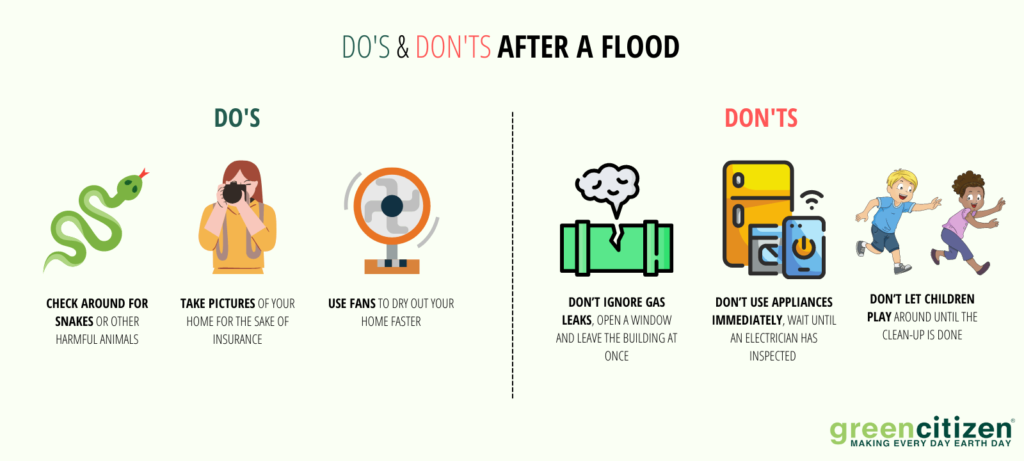
DON’T Ignore Gas Leaks
If you smell gas or hear a hissing noise, open a window and leave the building at once. Turn off the gas at the outside main valve and call the gas company.
DON’T Use Appliances Immediately
Even better don’t use the power at all until an electrician has inspected your wiring and appliances for safety. Even if they were not in direct contact with floodwater, your equipment has been in a damp area and might have soaked up moisture.
DON’T Let Children Play Around Until the Clean-Up is Done
Even if the flood is gone, your home and backyard can still hold many hazards. Exposed wires, cracked gas pipes, damaged walls, mold growth, etc.— all these things need to be taken care of before you can let the children run around again.
Flood Insurance Policies — Don’t Take It Lightly
Now, here’s the deal — Most home insurance packages don’t include flood damage.
I learned this hard way so you don’t have to.
It was only thanks to the state and municipality assistance that I didn’t have to apply for a hefty loan to make all repairs on the house.
Most insurance companies offer flood insurance as a separate policy that can cover buildings, the contents, or both.
And since your home and its contents are probably our most valuable asset, it’s worth insuring in the case of a flood.
Even if you don’t live in a flood-prone area, flooding can happen to you. Summer storms, broken water mains, or faulty construction in the neighborhood can cause flooding damage.
The best thing is that flood insurance works for you even if you’re renting. It doesn’t matter what kind of home insurance your landlord might have — if you insure your home contents against flood, you’re covered.
Actions You Could Take Today to Make A Difference
When a disaster strikes, even small, seemingly unimportant details can make a big difference. Here’s a list of easy actions that can buy you peace of mind when the water starts to rise.
Get your papers into the cloud. You should definitely keep important personal papers in a waterproof bag and close by. However, you should also scan those documents and upload them to a cloud-based storage system like Dropbox.
Prepare containers beforehand. While you can always rely on bottled water, the demand will be high at the first sight of flooding. It’s much easier to fill a number of plastic water cans with tap water and store them in a dark cold place.
Have back-flow valves installed. They don’t cost much and a professional plumber can install them in no time. These valves act as one-way gates, preventing floodwaters from coming up into the drain and into the house. This can give you precious more time to prepare your home.
Conclusion
The most recent floods across the globe remind us that violent torrents can be just as devastating as other extreme weather events.
A prompt and well-organized rescue effort can make a lot of difference, but in reality, the help often takes much longer to arrive.
This means that for at least a couple of days, every home must survive by itself.
In those situations, your strong mental mindset, resourcefulness, and your emergency kit are the only things your loved one can count on.
Do you have any flood tips to share?
If you have any questions about flooding safety tips and preparedness, feel free to ask.
